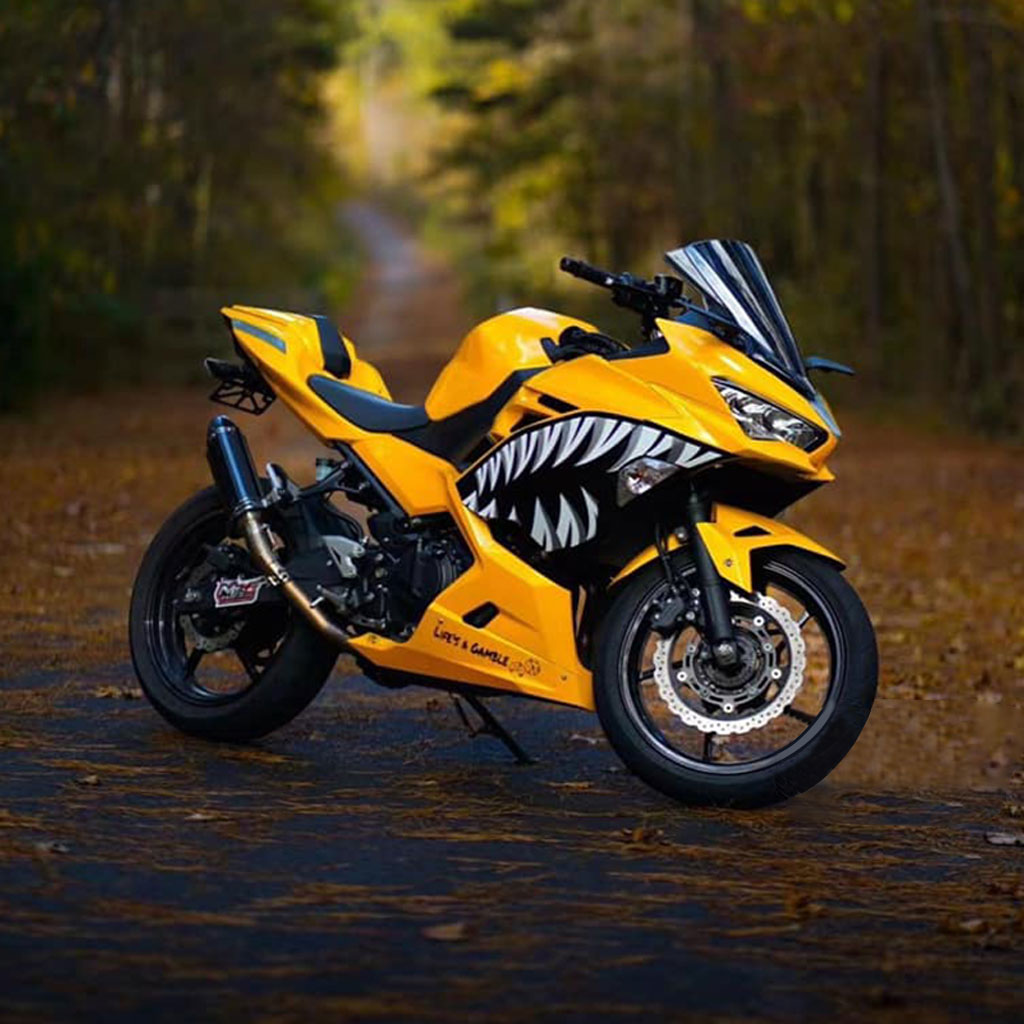Expert Advice on 2007 Suzuki GSXR 600 Upkeep
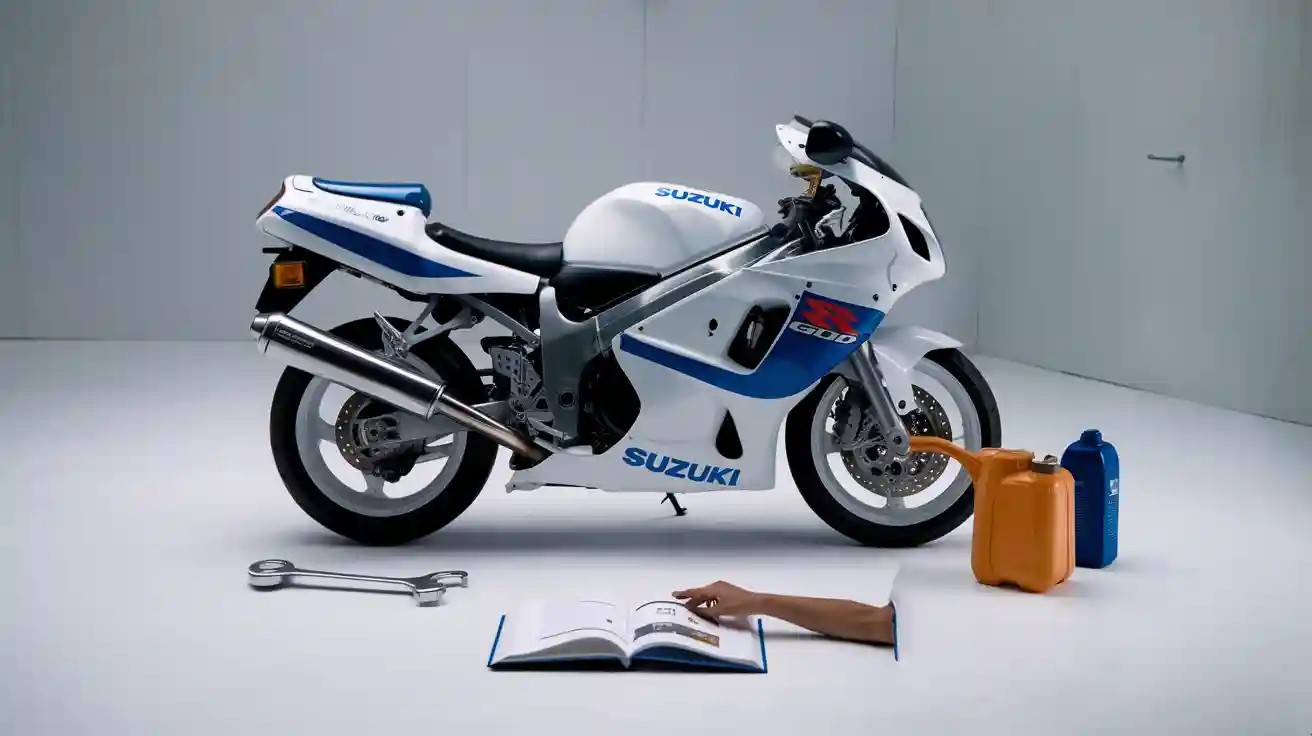
You keep your gsxr 600 suzuki 2007 running at its best by building smart habits. Simple steps like checking your oil, watching fluid levels, and cleaning your chain help your gsx-r600 last longer. About 22% of motorcycle accidents caused by mechanical failure link back to poor brake care, so you want to pay close attention to your brakes. When you follow proper maintenance, your gsx-r600’s vital parts, like the fuel pump, can last over 30,000 miles, giving your bike more longevity. These routines protect your gsx-r600 and boost its longevity on every ride.
GSXR 600 Suzuki 2007 Routine Maintenance Checklist
Oil and Filter Changes
You keep your gsx-r600 engine healthy by changing the oil and oil filter on a regular schedule. Experts recommend changing both every 3,000 miles, even though the factory manual suggests longer intervals. This more frequent schedule helps your gsx-r600 run smoother and last longer. The official interval for oil changes is every 5,000 km (about 3,100 miles) or every two years, but most experienced riders agree that 3,000 miles is best for real-world riding.
When you pick an oil filter for your gsx-r600, look for high-quality options like the K&N KN-138 or KN-138C. These filters work well with both synthetic and conventional oils. They offer strong construction and high oil flow, which protects your engine during every ride. You should avoid synthetic oil during the first 1,000 to 4,000 miles of your gsx-r600’s life, then switch to synthetic or blends for better protection.
Tip: Always warm up your engine before draining the oil. This helps the old oil flow out more easily and removes more dirt from inside the engine.
A simple oil and oil filter change routine keeps your gsx-r600 running at its best. You protect the engine from wear and help your bike stay reliable for years.
Chain Cleaning and Lubrication
Your gsx-r600 chain needs regular cleaning and lubrication to prevent wear and keep your ride smooth. You should lubricate the chain every 500 miles or whenever it looks dirty. Many riders lube the chain after every ride, especially if they ride in wet or dusty conditions. Clean the chain every 1,000 miles to remove grit and old lube.
| Maintenance Task | Recommended Frequency | Additional Notes |
|---|---|---|
| Chain Lubrication | Every 500 miles or when dirty | Lube after riding while the chain is warm. Some riders lube after every ride (200-250 miles). |
| Chain Cleaning | Every 1,000 miles | Use kerosene or a chain cleaner with a brush. Rinse and dry before lubing. |
For the best results, use a chain lube like Belray Superclean. This product sticks well and protects the steel parts inside your gsx-r600 chain. Molybdenum disulfide and graphite-based lubes also work well because they bond to metal and last longer. Avoid using WD40 or harsh solvents, as these can strip away needed lubrication and damage the chain.
Note: Always place your gsx-r600 on a stand before cleaning or lubing the chain. Spin the rear wheel by hand and never run the engine while working on the chain for safety.
A clean, well-lubed chain helps your gsx-r600 deliver smooth power and reduces the risk of costly repairs.
Brake Inspection and Adjustment
Brakes are one of the most important safety features on your gsx-r600. You should inspect the brake pads and the whole brake system every 12 months. Clean, adjust, or replace parts as needed. Replace the brake fluid every two years, since old fluid absorbs water and can lower braking performance.
| Interval | Brake Pads and System | Brake Fluid Replacement |
|---|---|---|
| Every 12 months | Inspect, clean, adjust, replace or lubricate as needed | Inspect |
| Every 24 months | Inspect | Replace |
Some riders change brake fluid every season for extra safety. Fresh fluid keeps your gsx-r600 brakes strong and reliable. Always check for signs of wear, like thin pads or spongy levers. If you notice any problems, fix them right away to avoid bigger issues.
Alert: Never let brake fluid go unchanged for more than four years. Old fluid can cause brake failure and put you at risk.
Regular brake maintenance gives you confidence every time you ride your gsxr 600 suzuki 2007. You stay safe, and your gsx-r600 stays ready for the road.
Coolant and Fluid Level Checks
You need to check your gsx-r600 coolant and fluid levels often. Coolant keeps your engine at the right temperature. If the coolant gets low, your engine can overheat. Overheating can damage the engine and cause expensive repairs. You should check the coolant level every month. Look at the reservoir when the engine is cold. The level should be between the "Full" and "Low" marks. If you see the coolant dropping, add the right type of coolant for your gsx-r600. Never open the radiator cap when the engine is hot. Hot coolant can spray out and burn you.
You also need to check other fluids. Brake fluid, clutch fluid, and engine oil all help your gsx-r600 run well. Low brake or clutch fluid can make your bike hard to control. Check these levels every month. Top them off if they get low. Use the fluids recommended in your owner’s manual. If you see leaks or dirty fluid, change it right away. Clean fluids help your gsx-r600 last longer and work better.
Tip: Always use a clean rag when checking or adding fluids. Dirt can get into the system and cause problems.
Air Filter Cleaning or Replacement
Your gsx-r600 engine needs clean air to run strong. The air filter keeps dirt and dust out of the engine. If the filter gets dirty, your engine cannot breathe well. You lose power and use more fuel. You should follow a regular air filter maintenance schedule to keep your gsx-r600 in top shape.
Here is a simple table to help you remember when to check, clean, or replace your air filter:
| Action | Distance (km) | Distance (miles) |
|---|---|---|
| Inspect/Clean | 6,000 | 4,000 |
| Inspect/Clean | 12,000 | 7,500 |
| Replace | 18,000 | 11,000 |
| Inspect/Clean | 24,000 | 14,500 |
You should inspect and clean the air filter every 6,000 km (4,000 miles) and 12,000 km (7,500 miles). Replace it at 18,000 km (11,000 miles). Use the SU-7506 air filter for the best fit and performance on your gsx-r600.
If you skip air filter maintenance, your gsx-r600 will not run well. Here are some problems you might see:
- Your engine feels weak or slow.
- You use more gas than normal.
- The engine may misfire or stall.
- The bike idles rough or makes strange noises.
- You see black smoke from the exhaust.
- Spark plugs get dirty and cause more misfires.
- The bike loses top speed and is hard to start.
- The engine may backfire.
- Parts inside the engine wear out faster.
- The engine does not last as long and makes more pollution.
You should always check, clean, or replace the air filter as part of your regular maintenance. If you ride in dusty places, check it more often. Clean air helps your gsx-r600 stay strong and reliable.
Battery Care
Your gsx-r600 needs a healthy battery to start and run all its systems. Most batteries last about 4 to 5 years if you ride your bike often and take good care of it. If you do not ride much or leave the bike sitting, the battery may not last as long. Using a battery tender can help the battery last longer by keeping it charged when you are not riding.
You should check the battery terminals for corrosion every month. Clean them if you see white or green buildup. Make sure the battery is tight in its holder. If your gsx-r600 has a maintenance-free battery, you do not need to add water. If it is not maintenance-free, check the fluid level and add distilled water if needed.
Note: If your bike is hard to start or the lights seem dim, your battery may be weak. Replace it before it fails so you do not get stranded.
Good battery care keeps your gsx-r600 ready to ride. Regular checks and cleaning help you avoid problems and keep your bike reliable.
Spark Plug Inspection
Spark plugs play a key role in your gsx-r600’s engine. They ignite the fuel and air mixture, which powers your ride. If you want your gsx-r600 to run smoothly, you need to check and replace the spark plugs at the right times. Regular spark plug inspection is a vital part of your gsx-r600 maintenance routine.
You should follow a set schedule for spark plug inspection and replacement. The 2007 Suzuki GSXR 600 uses NGK CR9E spark plugs. The table below shows when you should inspect and replace them:
| Interval (km) | Interval (miles) | Action on Spark Plugs (NGK CR9E) |
|---|---|---|
| 6,000 | 3,500 | Inspect |
| 12,000 | 7,500 | Replace |
| 18,000 | 11,000 | Inspect |
| 24,000 | 14,500 | Replace |
You can also see the spark plug maintenance pattern in this chart:
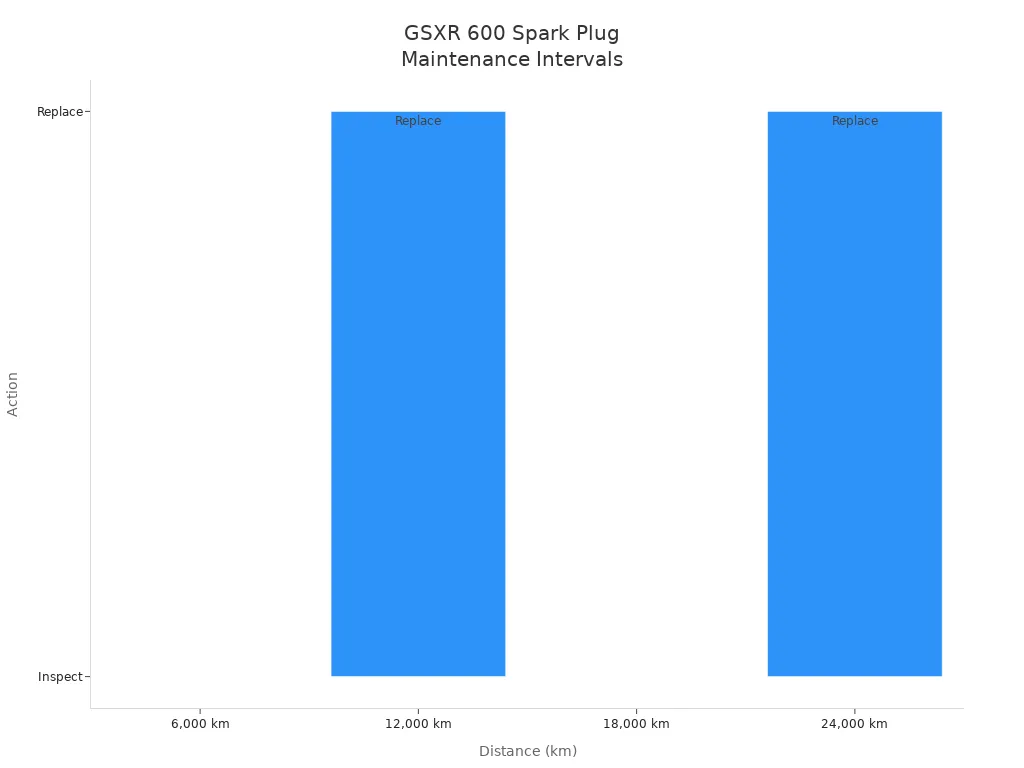
When you inspect your gsx-r600 spark plugs, you look for signs of wear or damage. Worn spark plugs can cause many problems for your gsx-r600. You might notice your bike does not start easily or runs rough. You could see a drop in power or hear strange noises from the engine. These are all signs that your spark plugs need attention.
Here are some common signs of spark plug wear or failure on your gsx-r600:
- Reduced fuel economy. Your gsx-r600 uses more gas than normal.
- Engine runs hotter than usual. This can lead to overheating.
- Decreased acceleration and power. Your gsx-r600 feels sluggish.
- Visible carbon deposits or worn electrodes on the spark plug.
- Unusual engine noises like rattling or knocking.
- Misfiring engine. The gsx-r600 does not run smoothly.
- Backfiring with loud pops from the exhaust.
- Flooded engine. You smell strong gas or see gas from the exhaust.
- Burn marks or white spots on the spark plug.
- Broken or bent spark plug parts.
- Rust or corrosion on the spark plug.
- Old spark plugs that have passed the recommended mileage.
- Damaged spark plug wires.
Tip: Always let your gsx-r600 engine cool before removing spark plugs. Hot parts can burn you.
When you inspect the spark plugs, remove them one at a time. Look for black soot, oil, or white deposits. These signs show your gsx-r600 may have a fuel or ignition problem. If you see damage or heavy deposits, replace the spark plug right away. Use only the recommended NGK CR9E plugs for your gsx-r600.
You should always include spark plug checks in your regular gsx-r600 maintenance. Clean or replace them as needed. This keeps your gsx-r600 running strong and helps prevent bigger engine problems. Good spark plugs mean better starts, smoother rides, and more power every time you hit the road.
GSX-R600 Maintenance Schedule and Service Intervals
Maintenance Schedule Overview
You want your gsx-r600 to run well for many years. The best way to do this is to follow the official maintenance schedule. This schedule tells you when to check, replace, or adjust important parts. You should always use the gsx-r600 maintenance schedule as your main guide. It helps you know the right service intervals for every part of your bike.
The gsx-r600 maintenance schedule covers all the main systems. You check the air cleaner, spark plugs, valve clearance, engine oil, coolant, brakes, and more. Each part has its own service intervals. Some parts need attention every 6,000 km or 12 months. Others need work every 12,000 km or 24 months. You also have tasks that come up every 18,000 km or 36 months, and some at 24,000 km or 48 months.
Tip: Always write down the date and mileage when you finish each gsx-r600 maintenance task. This helps you remember your next service intervals.
You should never skip a step in the gsx-r600 maintenance schedule. Missing service intervals can cause problems and cost you more money later. If you ride in tough conditions, you may need to do some gsx-r600 maintenance tasks more often.
Service Interval Table
The table below shows the main gsx-r600 maintenance schedule and service intervals. You can use this as a quick guide for your regular checks and replacements.
| Maintenance Item | 6,000 km (12 mo) | 12,000 km (24 mo) | 18,000 km (36 mo) | 24,000 km (48 mo) |
|---|---|---|---|---|
| Air cleaner element | Inspect | Inspect | Replace | Inspect |
| Spark plugs | Inspect | Replace | Inspect | Replace |
| Valve clearance | - | - | - | Inspect |
| Engine oil | Replace | Replace | Replace | Replace |
| Engine oil filter | - | - | Replace | - |
| Brake fluid | Inspect | Inspect | Inspect | Inspect |
| Brake hose | Inspect | Inspect | Inspect | Inspect |
- Replace engine coolant every 4 years.
- Replace brake fluid every 2 years.
- Clean and lubricate the drive chain every 1,000 km (600 miles).
- Tighten chassis bolts and nuts at every service interval.
You should follow this gsx-r600 maintenance schedule closely. The right service intervals keep your gsx-r600 safe and strong. When you stick to the gsx-r600 maintenance schedule, you avoid big repairs and enjoy every ride.
Key Parts and Supplies for GSXR 600 Suzuki 2007 Maintenance
Essential Tools for Maintenance
You need the right tools to follow the gsx-r600 maintenance schedule and keep your bike in top shape. These tools help you complete routine maintenance and stick to the correct service intervals. Here is a list of essential tools for your gsx-r600:
- Metric Allen keys (3mm to 10mm or more)
- Metric socket set (6mm to 22mm, including an extra socket for the axle nut)
- Metric wrench set (6mm to 22mm)
- Needle nose pliers (bent and straight)
- Side cutter
- Adjustable plumber wrench (for removing the oil filter)
- Dead blow hammer
- Heavy duty grease
- Blue Loctite (thread locker)
- Phillips screwdriver
- Flat head screwdriver
You should also keep a voltmeter for electrical checks and a stainless steel ruler for measuring chain tension and spark plug gap. These tools make it easier to follow your gsx-r600 maintenance schedule and meet all service intervals.
Tip: Store your tools in a safe, dry place. Clean tools last longer and help you care for your gsx-r600.
Recommended Fluids and Lubricants
Choosing the right fluids and lubricants is key for gsx-r600 maintenance. Many riders use synthetic motor oils like AMSOIL MC 10w40 or Rotella T 5w40 after the break-in period. These oils protect your gsx-r600 engine during long rides and extreme temperatures. For the first 300 miles, you can use OEM oil, then switch to synthetic for better performance. Rotella synthetic oils work well with wet clutches and do not harm clutch performance.
You should always check your gsx-r600 maintenance schedule for the correct oil viscosity and certification. For the brake system, AMSOIL DOT 3 and DOT 4 synthetic brake fluids help prevent brake fade and keep your gsx-r600 safe. These fluids meet or exceed manufacturer standards, so you can trust them for every service interval.
Note: Always use fluids that match the gsx-r600 maintenance schedule. The right fluids help you avoid problems and keep your bike running strong.
Replacement Parts List
You need to keep certain replacement parts on hand to follow your gsx-r600 maintenance schedule and meet all service intervals. This table shows the most important parts for your gsx-r600:
| Part Name | Recommended Replacement Interval (Service Intervals) |
|---|---|
| Oil filter | Every oil change (see maintenance schedule) |
| Air filter | Every 18,000 km or as needed |
| Spark plugs | Every 12,000 km or as needed |
| Brake pads | Inspect every 12 months, replace as needed |
| Chain and sprockets | Inspect every 1,000 km, replace if worn |
| Coolant | Every 4 years |
| Brake fluid | Every 2 years |
| Battery | Every 4-5 years or as needed |
You should check these parts during each gsx-r600 maintenance session. Replacing them at the right service intervals helps you avoid breakdowns and keeps your gsx-r600 reliable.
GSX-R600 Tire Care and Inspection
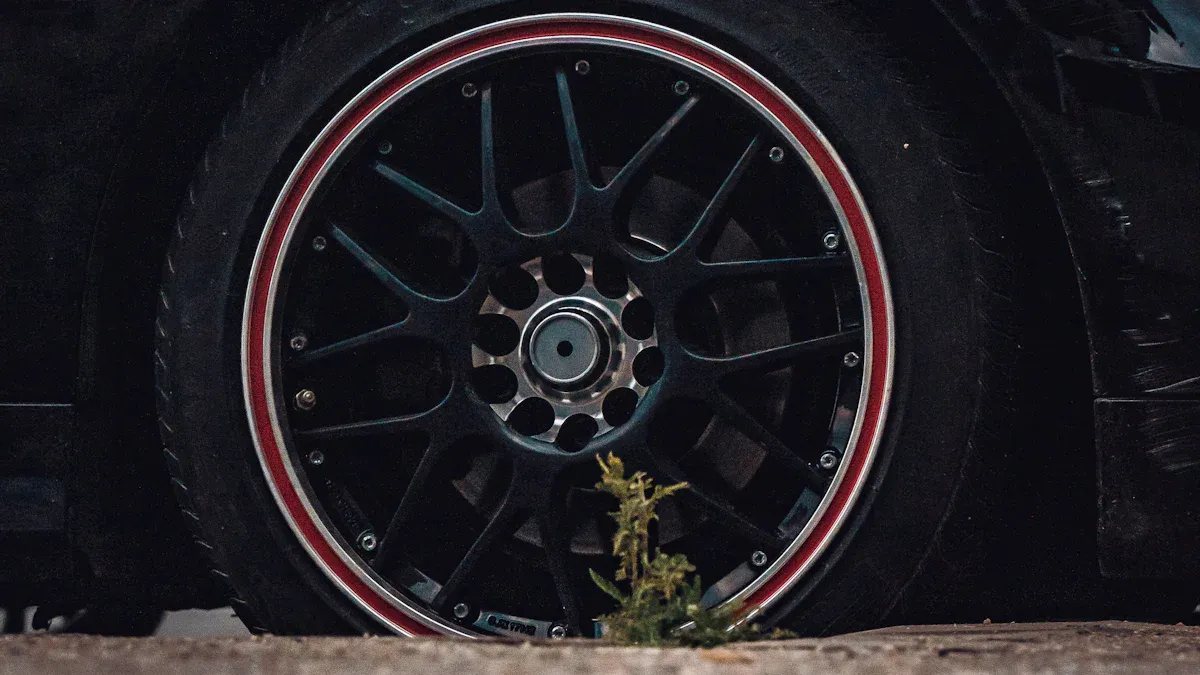
Correct Tire Sizes for GSXR 600 Suzuki 2007
You need the right tire sizes to keep your gsx-r600 safe and performing well. The 2007 model uses a front tire size of 120/70-17 and a rear tire size of 180/55-17. These sizes match the manufacturer’s specifications and fit all gsx-r600 models from 1998 to 2014. Using the correct tire size helps your bike handle better and keeps you safe on the road.
- Front Tire Size: 120/70-17
- Rear Tire Size: 180/55-17
- These sizes also match the section width, load rating, and aspect ratio needed for your gsx-r600.
If you use the wrong tire size, you may notice poor handling or extra wear. Always check your owner’s manual or ask a trusted shop before buying new tires for your gsxr 600 suzuki 2007.
Proper Tire Pressures
Tire pressure affects how your gsx-r600 rides, stops, and turns. You should check your tire pressure at least once a week. The recommended pressures can change based on how you ride. For normal street riding, Suzuki recommends 36 psi for both the front and rear tires. Some riders use 36 psi in the front and 42 psi in the rear for extra load. If you ride on a track, you may lower the pressure for better grip.
| Riding Condition | Front Tire Pressure (psi) | Rear Tire Pressure (psi) |
|---|---|---|
| Solo Street Riding | 36 | 36 |
| Normal Street Riding | 36 | 42 |
| Track Riding - Fast Track | 32 | 34 |
| Track Riding - Slow Track | 30 | 32 |
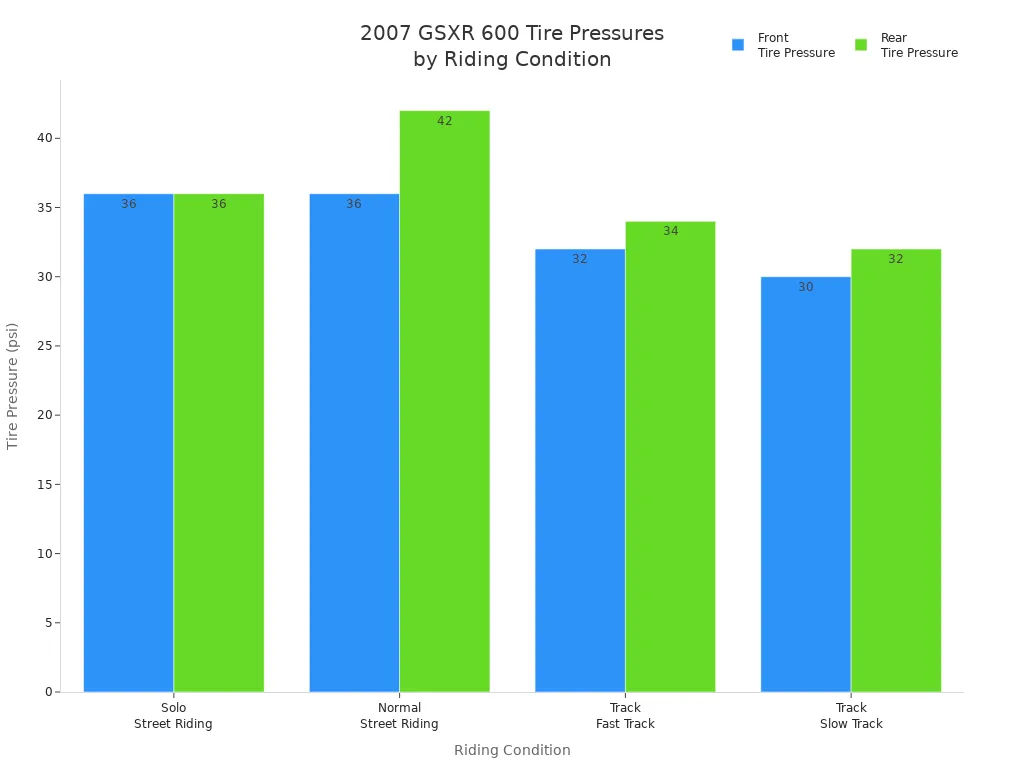
Tip: Always check tire pressure when the tires are cold. Hot tires can give a false reading.
Never use the maximum pressure listed on the tire wall as your guide. Stick to the numbers in your manual or the table above. Adjust the pressure if you change your riding style or carry extra weight.
Tread and Sidewall Inspection
You should inspect your gsx-r600 tires before every ride. Look for cuts, cracks, or bulges on the sidewalls. Check the tread depth to make sure you have enough grip. If the tread is worn down to the wear bars, it is time to replace the tire. Uneven wear can mean your tire pressure is wrong or your wheels are out of alignment.
- Look for stones or sharp objects stuck in the tread.
- Check for any signs of dry rot or aging.
- Make sure there are no bubbles or soft spots on the sidewall.
Alert: Riding on worn or damaged tires can cause loss of control. Replace tires right away if you see any damage.
Regular tire care keeps your gsx-r600 handling well and helps you avoid accidents. Good tires give you better grip, smoother rides, and more confidence every time you hit the road.
Pro Tips for Preventing Common GSX-R600 Issues
Avoiding Chain and Sprocket Wear
You want your gsx-r600 to deliver smooth power every ride. Chain and sprocket wear can cause jerky movement and even damage your bike. Clean and lubricate your chain often, especially after riding in rain or dust. Use a quality chain lube and avoid harsh chemicals. Check the chain tension with a ruler. If the chain feels loose or tight in spots, adjust it right away. Inspect the sprockets for hooked or worn teeth. Replace them if you see sharp points or missing metal. Always align the rear wheel when you adjust the chain. This helps your gsx-r600 run quietly and keeps the drivetrain healthy.
Tip: Lubricate your chain after each wash or every 500 miles. This habit extends the life of your gsx-r600 chain and sprockets.
Preventing Overheating
Overheating can harm your gsx-r600 engine. You can prevent this problem by following a few simple steps:
- Check coolant levels often and replace coolant every year. This keeps the system clean and free from clogs.
- Change engine oil every 3,000 to 4,000 miles. Use the correct oil grade for your gsx-r600 to help manage heat.
- Inspect and clean radiator fins. Remove bugs and dirt so air can flow freely.
- Make sure the radiator fan works. The fan helps cool your gsx-r600 when you stop or move slowly.
- Ride during cooler times of day. Early morning or late evening rides reduce heat stress.
- Avoid heavy traffic and long idling. Keep moving to let air cool your gsx-r600.
- Ride at steady speeds. High RPMs create more heat, so shift early and ride smooth.
- If you see steam or a high temperature gauge, pull over and turn off your gsx-r600. Wait at least 30 minutes before checking coolant. Never open the radiator cap when hot.
- If overheating continues, ask a mechanic to check for problems like a bad water pump or clogged radiator.
These steps help your gsx-r600 stay cool and protect your engine from damage.
Protecting Electrical Components
Electrical issues can stop your gsx-r600 fast. You can protect these parts with a few easy habits:
- Do not spray high-pressure water near the fuel pump relay or under the seat. Use a damp cloth for cleaning instead.
- Check rubber grommets and drain holes. Make sure they are in place to keep water out.
- Keep battery terminals clean and tight. Dirty or loose terminals can cause voltage drops.
- Check that the relay sits firmly in its socket. A loose relay can cause connection problems.
- Use electrical contact cleaner on relay pins if you remove them. This reduces corrosion and keeps your gsx-r600 running strong.
- Keep your battery healthy. A strong battery puts less strain on your gsx-r600’s electrical system.
Note: Regular maintenance of your gsx-r600’s electrical parts helps prevent sudden breakdowns and keeps your bike reliable.
Storing Your Bike Properly
Proper storage keeps your gsx-r600 in top shape during long breaks. You protect your bike from rust, battery drain, and other problems when you follow the right steps. Good storage is a key part of your maintenance routine.
Start by cleaning your bike. Dirt and grime can cause rust if left on the surface. Dry your gsx-r600 completely before you store it. Next, change the oil and filter. Old oil holds acids and dirt that can harm your engine during storage.
You should also fill the gas tank and add a fuel stabilizer. This step prevents the fuel from breaking down and keeps the inside of your tank from rusting. Run the engine for a few minutes to let the stabilizer reach the fuel system.
Check all fluid levels. Top off the coolant, brake fluid, and clutch fluid. These fluids help protect your gsx-r600 from corrosion and keep seals from drying out. Lubricate the chain and any moving parts. This step stops rust and keeps everything moving smoothly.
Remove the battery if you plan to store your bike for more than a month. Store the battery in a cool, dry place and use a battery tender to keep it charged. This simple maintenance step helps your battery last longer.
Store your gsx-r600 in a dry, covered area. Use a breathable cover to keep dust off but let moisture escape. Avoid plastic tarps, as they trap water and cause rust.
Tip: Place your bike on stands to take weight off the tires. This prevents flat spots and keeps your tires in good condition.
Proper storage is just as important as regular maintenance. You protect your investment and make sure your gsx-r600 is ready to ride when you are.
Signs of Wear to Watch For on GSXR 600 Suzuki 2007
Engine Performance Changes
You want your gsx-r600 to run strong every time you ride. Watch for changes in how your engine performs. These signs can warn you when your gsx-r600 needs attention:
- You have trouble starting your gsx-r600, especially when the engine is cold. The bike may crank for a long time or need several tries before it starts.
- The engine hesitates or stumbles when you speed up. This often means your gsx-r600 is not getting enough fuel.
- You notice a loss of power at high RPMs. The engine may flatten out or feel weak when you push it hard.
- Your gsx-r600 stalls at idle or while riding. This is a serious sign that you should not ignore.
- The idle feels rough or unstable. The RPMs may jump up and down.
- You hear a loud whine, grinding, or screeching from the fuel pump during the ignition cycle. Sometimes, you may not hear the normal pump sound at all.
- The bike takes longer to start, even when warm.
- You see your fuel economy drop. Your gsx-r600 uses more gas than usual.
To help prevent these problems, always use clean fuel and avoid running your tank low. Add a fuel stabilizer if you store your gsx-r600 for a long time. Check and replace the fuel pump strainer as part of your regular maintenance.
Tip: Listen for the normal fuel pump whine when you turn the key. A change in this sound can be an early warning.
Unusual Noises or Vibrations
Strange sounds or vibrations can signal trouble with your gsx-r600. Pay close attention to anything that feels or sounds different. You might hear knocking, rattling, or grinding from the engine. These noises can mean loose bolts, worn bearings, or problems inside the engine. If you feel new vibrations through the handlebars or seat, check your tires, wheels, and chain. Unusual vibrations can also come from misaligned wheels or worn suspension parts. Always investigate new noises or shakes right away. Quick action can stop small issues from becoming big repairs.
Alert: Never ignore loud or sudden noises. Stop your gsx-r600 and check for problems before riding again.
Brake Fade or Sponginess
Your gsx-r600 brakes should feel firm and strong. If you notice the lever feels soft or spongy, air may have entered the brake lines. Brake fade happens when the brakes lose power after heavy use. You might need to pull the lever farther to stop, or the brakes may not slow your gsx-r600 as quickly as before. Worn brake pads, old fluid, or overheating can cause these problems. Always check your brake pads and fluid if you feel any change in braking. Replace worn parts and bleed the brakes if needed. Good brakes keep you safe every time you ride your gsx-r600.
Tip: Test your brakes before every ride. A quick check can help you catch problems early.
Fluid Leaks
Fluid leaks can cause big problems for your GSXR 600 Suzuki 2007. You need to check for leaks often to keep your bike safe and running well. Leaks can come from many places on your motorcycle. Each type of fluid has its own color and smell. Knowing what to look for helps you fix problems early.
Common Fluids That May Leak:
| Fluid Type | Color | Where to Check | What It Means |
|---|---|---|---|
| Engine Oil | Amber/Brown | Under engine, near drain plug | Possible gasket or seal leak |
| Coolant | Green/Blue | Under radiator, hoses | Hose or radiator problem |
| Brake Fluid | Clear/Yellow | Near brake lines, calipers | Brake system leak |
| Fork Oil | Clear/Light | Around front forks | Fork seal issue |
| Gasoline | Clear/Yellow | Under tank, fuel lines | Fuel line or tank leak |
Tip: Place a clean piece of cardboard under your bike overnight. In the morning, check for spots. This helps you find leaks you might miss during the day.
How to Spot a Leak:
- Look for wet spots or puddles under your bike.
- Check for drips on hoses, bolts, or the engine.
- Smell for strong odors like gas or coolant.
- Feel for sticky or oily spots on parts.
If you find a leak, do not ignore it. Small leaks can turn into big repairs. Fix leaks as soon as you see them. Replace worn gaskets, seals, or hoses. Tighten loose bolts. Clean up any spilled fluid right away.
🚨 Alert: Never ride your GSXR 600 if you see brake fluid leaking. This can cause brake failure and put you in danger.
Check your fluids often. Catching leaks early keeps your bike safe and saves you money. Regular checks help you enjoy every ride with confidence.
You protect your gsxr 600 suzuki 2007 by following a regular maintenance schedule. When you stick to the maintenance schedule, you help your bike run better and last longer. Small steps in maintenance keep problems away and support the longevity of your motorcycle. Always check your maintenance schedule and make it a habit. This routine gives you peace of mind and boosts the longevity of your GSX-R600.
Stay on top of your maintenance schedule. Your effort today means a safer ride tomorrow.
FAQ
How often should you change the oil on your 2007 GSXR 600?
You should change the oil every 3,000 miles. This keeps your engine clean and running strong. Always use the oil type listed in your owner’s manual.
What is the best way to clean your GSXR 600 chain?
Use a soft brush and kerosene or a chain cleaner. Wipe the chain dry, then apply chain lube. Spin the rear wheel by hand for even coverage.
How do you know when to replace your brake pads?
Check the thickness of your brake pads. If they look thin or you hear squeaking, replace them. Good pads help you stop safely every time.
What tire pressure should you use for street riding?
Set both front and rear tires to 36 psi for normal street riding. Always check tire pressure when the tires are cold for the most accurate reading.
How can you keep your battery healthy during winter storage?
Remove the battery from your bike. Store it in a cool, dry place. Use a battery tender to keep it charged. This helps your battery last longer.
See Also
How To Properly Care For Your First Motorcycle
Money-Saving Tips For Effective Motorcycle Repairs
Advantages Of Installing New Fairings On Suzuki GSXR
Best Practices For Cleaning And Maintaining Motorcycle Fairings
